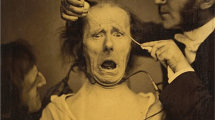Abstract
The primary aim of the current study was to evaluate discomfort levels of facial NMES in healthy volunteers. Eight participants completed the Discomfort Level Scale (DLS) following each motor level facial neuromuscular electrical stimulation (NMES) session. Each participant completed 12 sessions of facial NMES for a total of 96 NMES treatments. Pearson product-moment correlation coefficient demonstrated a significant correlation between the facial NMES intensity level and DLS (p < 0.001). This study demonstrated that the DLS is a useful tool to check for discomfort levels in patients who receive facial NMES. Further, this study provides strong support for the tolerability of facial NMES.

Similar content being viewed by others
Data Availability
The data that support the findings of this study are available on request from the corresponding author, [MS].
References
Sheffler LS, Chae J (2007) Neuromuscular electrical stimulation in neurorehabilitation. Muscle Nerve. https://doi.org/10.1002/mus.20758
Miki H, Hida W, Chonan T, Kikuchi Y, Takishima T (1989) Effects of submental electrical stimulation during sleep on upper airway patency in patients with obstructive sleep apnea. Am Rev Respir Dis. https://doi.org/10.1164/ajrccm/140.5.1285
Mezzanotte WS, Tangel DJ, White DP (1992) Waking genioglossal electromyogram in sleep apnea patients versus normal controls (a neuromuscular compensatory mechanism). J Clin Invest. https://doi.org/10.1172/JCI115751
Isono S, Tanaka A, Nishino T (1999) Effects of tongue electrical stimulation on pharyngeal mechanics in anaesthetized patients with obstructive sleep apnoea. EurRespir J. https://doi.org/10.1183/09031936.99.14612589
Oliven A, Schnall RP, Pillar G, Gavriely N, Odeh M (2001) Sublingual electrical stimulation of the tongue during wakefulness and sleep. RespirPhysiol. https://doi.org/10.1016/S0034-5687(01)00254-7
Randerath WJ, Galetke W (2006) The upper airway muscles: structural and pathophysiological aspects in the obstructive sleep apnoea syndrome. Somnologie. https://doi.org/10.1111/j.1439-054X.2006.00104.x
Alakram P, Puckree T (2017) Effects of electrical stimulation in early Bells palsy on facial disability index scores. S Afr J Physiother. https://doi.org/10.4102/sajp.v67i2.44
Kavanagh S, Newell J, Hennessy M, Sadick N (2012) Use of a neuromuscular electrical stimulation device for facial muscle toning: a randomized, controlled trial. J CosmetDermatol. https://doi.org/10.1111/jocd.12007
Safi MF, Wright-Harp W, Lucker JR, Payne JC (2017) Effect of surface neuromuscular electrical stimulation on labial and lingual muscles in healthy volunteers. Int J Rehabil Res. https://doi.org/10.1097/MRR.0000000000000217
Safi MF, Wright-Harp W, Lucker JR, Payne JC, Harris O (2018) Effect of neuromuscular electrical stimulation on labial and lingual weakness: a single-case preexperimental study. Top GeriatrRehabil. https://doi.org/10.1097/TGR.0000000000000185
Humbert IA, Poletto CJ, Saxon KG et al (2005) The effect of surface electrical stimulation on hyolaryngeal movement in normal individuals at rest and during swallowing. J ApplPhysiol. https://doi.org/10.1152/japplphysiol.00348.2006
Ludlow CL, Humbert I, Saxon K, Poletto C, Sonies B, Crujido L (2007) Effects of surface electrical stimulation both at rest and during swallowing in chronic pharyngeal dysphagia. Dysphagia. https://doi.org/10.1007/s00455-006-9029-4
Nam HS, Beom J, Oh BM, Han TR (2013) Kinematic effects of hyolaryngeal electrical stimulation therapy on hyoid excursion and laryngeal elevation. Dysphagia. https://doi.org/10.1007/s00455-013-9465-x
Kawakami T, Ishihara M, Mihara M (2001) Distribution density of intraepidermal nerve fibers in normal human skin. J Dermatol. https://doi.org/10.1111/j.1346-8138.2001.tb00091.x
Connor NP, Abbs JH (1998) Orofacial proprioception: analyses of cutaneous mechanoreceptor population properties using artificial neural networks. J CommunDisord. https://doi.org/10.1016/S0021-9924(98)00024-0
Hung J, Samman N (2009) Facial skin sensibility in a young healthy chinese population. Oral Surg Oral Med Oral Pathol Oral RadiolEndodontology. https://doi.org/10.1016/j.tripleo.2008.10.026
Kliger M, Stahl S, Haddad M, Suzan E, Adler R, Eisenberg E (2015) Measuring the intensity of chronic pain: are the visual analogue scale and the verbal rating scale interchangeable? Pain Pract. https://doi.org/10.1111/papr.12216
Ferreira-Valente MA, Pais-Ribeiro JL, Jensen MP (2011) Validity of four pain intensity rating scales. Pain. https://doi.org/10.1016/j.pain.2011.07.005
Littman GS, Walker BR, Schneider BE (1985) Reassessment of verbal and visual analog ratings in analgesic studies. ClinPharmacolTher. https://doi.org/10.1038/clpt.1985.127
Guyatt GH, Townsend M, Berman LB, Keller JL (1987) A comparison of Likert and visual analogue scales for measuring change in function. J Chronic Dis 40(12):1129–1133
Averbuch M, Katzper M (2004) Assessment of visual analog versus categorical scale for measurement of osteoarthritis pain. J ClinPharmacol. https://doi.org/10.1177/0091270004263995
Safi MF et al (2014) A review of electrical stimulation and its effect on lingual, labial and buccal muscle strength. Int J Orofacial Myol 40:12–29
Fillingim RB, King CD, Ribeiro-Dasilva MC, Rahim-Williams B, Riley JL (2009) Sex, gender, and pain: a review of recent clinical and experimental findings. J Pain. https://doi.org/10.1016/j.jpain.2008.12.001
Funding
No funding was received for this research
Author information
Authors and Affiliations
Corresponding author
Additional information
Publisher's Note
Springer Nature remains neutral with regard to jurisdictional claims in published maps and institutional affiliations.
Rights and permissions
About this article
Cite this article
Safi, M. Assessing Discomfort Levels During Facial Neuromuscular Electrical Stimulation Using Discomfort Level Scale: A Preliminary Study. Indian J Otolaryngol Head Neck Surg 74 (Suppl 3), 5275–5279 (2022). https://doi.org/10.1007/s12070-020-02173-5
Received:
Accepted:
Published:
Issue Date:
DOI: https://doi.org/10.1007/s12070-020-02173-5




